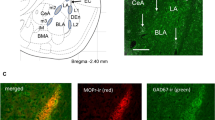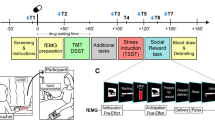Abstract
An exposure for 30 min to a 0.5 Hz rotating magnetic field (1.5–90 G) significantly reduced immobilization stress-induced, opioid analgesia and hyperactivity in CF-1 and C-57 BL strains of mice, respectively. The magnetic exposure also eliminated the day-night rhythm in stress-induced analgesia, with maximum inhibitory effects occurring in the dark period. Pre-treatment with naloxone (1.0 mg/kg) had comparable inhibitory effects on immobilization-induced analgesia and activity. These results suggest that exposure to magnetic stimuli can significantly influence stress-induced activation of endogenous opioid systems and their behavioral and physiological consequences.
Similar content being viewed by others

References
Adey WR (1981) Tissue interactions with nonionizing electromagnetic fields. Physiol Rev 61:435–513
Akil H, Watson SJ, Young E, Lewis ME, Khachaturian H, Walker JM (1984) Endogenous opioids: biology and function. Ann Rev Neurosci 7:223–255
Bawin SM, Adey WR, Sabbot IM (1978) Ionic factors in the release of Ca35++ from chicken cerebral tissue by electromagnetic fields. Proc Natl Acad Sci 75:6314–6318
Blackman CF, Beane SG, House DR, Joines WT (1985a) Effects of ELF (1–1120 Hz) and modulated (50 Hz) RF fields on the efflux of calcium ions from brain tissue in vitro. Bioelectromagnetics 6:1–11
Blackman CF, Beane SG, Rabinowitz JR, House DR, Joines WT (1985b) A role for the magnetic field in the radiation-induced efflux of calcium ions from brain tissue in vitro. Bioelectromagnetics 6:327–337
Bodnar RJ, Kelly DD, Brutus M, Glasman M (1980) Stress-induced analgesia: neural and hormonal determinants. Neurosci Biobehav Rev 4:87–100
Chapman DB, Way EL (1982) Modification of endorphin/enkephalin analgesia and stress induced analgesia by divalent ions, a cation chelator and an ionophore. Br J Pharmacol 75:389–396
Davis HP, Mizumori SJY, Allen H, Rosenzweig AR, Bennett EL, Tenforde TS (1984) Behavioral studies with mice exposed to DC and 60-Hz magnetic fields. Bioelectromagnetics 5:147–164
Frischknecht HF, Siegfried B, Riggio G, Waser PG (1983) Inhibition of morphine-induced and analgesia and locomotor activity in strains of mice: a comparison of long-acting opiate agonists. Pharmacol Biochem Behav 19:939–944
Golding GP, Newboult L, Rees JMH, Varlow BR (1985) The effects of 50 Hz magnetic fields on opioid peptide mediated inhibition of guinea pig ileum. Neuropeptides 5:357–358
Guerrero-Munoz F, Adames C, Fearon Z, Way EL (1981) Calcium-opiate antagonism in the periaqueductal gray (PGA) region. Eur J Pharmacol 76:417–419
Kafka MS, Wirz-Justice A, Naber D, Moore RY, Benedit MA (1983) Circadian rhythms in brain neurotransmitter receptors. Fed Proc 42:2796–2801
Kavaliers M, Hirst M (1983) Daily rhythms of analgesia in mice: effects of age and photoperiod. Brain Res 279:387–393
Kavaliers M, Hirst M (1986) Inhibitory influences of FMRFamide and PLG on stress-induced opioid analgesia and activity. Brain Res (in press)
Kavaliers M, Ossenkopp K-P (1984) Effects of 0.5 Hz and 60 Hz magnetic fields on morphine-induced behavioral changes in mice. Soc Neurosci Abstr 10:1105
Kavaliers M, Ossenkopp K-P (1985) Exposure to rotating magnetic fields alters morphine-induced behavioral responses in two strains of mice. Neuropharmacology 4:337–340
Kavaliers M, Ossenkopp K-P (1986a) Magnetic field inhibition of morphine-induced analgesia and behavioral activity in mice: evidence for involvement of calcium ions. Brain Res (in press)
Kavaliers M, Ossenkopp K-P (1986 b) Magnetic fields differentially inhibit mu, delta, kappa and sigma opiate-induced analgesia in mice. Peptides (in press)
Kavaliers M, Hirst M, Teskey GC (1983) Ageing, opioid analgesia and the pineal gland. Life Sci 32:2279–2287
Kavaliers M, Ossenkopp K-P, Hirst M (1984) Magnetic fields abolish the enhanced nocturnal analgesic response to morphine in mice. Physiol Behav 32:261–264
Kavaliers M, Ossenkopp K-P, Mathers A (1985) Magnetic fields inhibit opioid-induced feeding in the slug,Limax maximus. Pharmacol Biochem Behav 23:626–639
Martin WR (1984) Pharmacology of opioids. Pharmacol Rev 35:282–323
Miller DB, Blackman CF, Ali JS (1985) Behavioral responses of morphine-treated mice to ELF magnetic fields. Abstr Bioelectromag Soc 1985:54
Naber D, Wirtz-Justice A, Kafka MS (1981) Circadian rhythm in brain opiate receptors. Neurosci Lett 21:45–50
Oliverio A, Castellano C, Puglisi-Allegra S (1983) Psychopharmacogenetics of opioids. TIPS 4:350–353
Ossenkopp K-P, Kavaliers M, Hirst M (1983) Reduced nocturnal morphine analgesia in mice following a geomagnetic disturbance. Neurosci Lett 40:321–325
Ossenkopp K-P, Kavaliers M, Prato FS, Teskey GC, Sestini E, Hirst M (1985) Exposure to nuclear magnetic resonance imaging procedures attenuates morphine-induced analgesia in mice. Life Sci 37:1507–1514
Przewlocki R, Lason W, Konecha AM, Gramsch C, Herz A, Reid LD (1983) The opioid dynorphin, circadian rhythms and starvation. Science 219:71–73
Reggiani A, Battani F, Kobayashi H, Spano P, Trabuchi M (1980) Genotype-dependent sensitivity to morphine: role of different opiate receptors. Brain Res 1898:289–294
Semm P, Schneider T, Vollrath L (1980) The effects of an earthstrength magnetic field on the electrical activity of pineal cells. Nature 288:607–608
Welker HA, Semm P, Willig RP, Commentz JC, Wiltschko W, Vollrath L (1983) Effects of an artificial magnetic field on serotonin N-acetyltransferase activity and melatonin content of the rat pineal gland. Exp Brain Res 50:426–432
Author information
Authors and Affiliations
Rights and permissions
About this article
Cite this article
Kavaliers, M., Ossenkopp, KP. Stress-induced opioid analgesia and activity in mice: Inhibitory influences of exposure to magnetic fields. Psychopharmacology 89, 440–443 (1986). https://doi.org/10.1007/BF02412118
Received:
Revised:
Issue Date:
DOI: https://doi.org/10.1007/BF02412118



